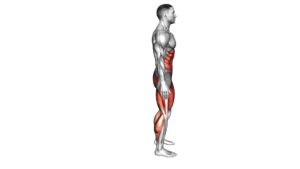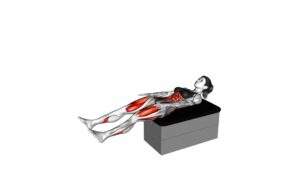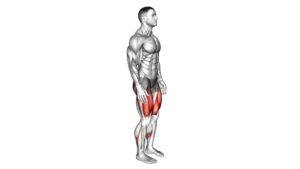Sit-up Stand-up – Video Exercise Guide & Tips

Are you looking for an effective and efficient way to strengthen your core? Look no further than sit-up stand-ups!
Watch This Exercise Video
In this video exercise guide, we'll show you the proper form and technique to get the most out of this exercise.
We'll also share common mistakes to avoid, variations and progressions to keep challenging yourself, and tips for maximizing your results.
Get ready to transform your core with sit-up stand-ups!
Key Takeaways
- Sit-up stand-ups target multiple muscle groups simultaneously.
- Proper form and technique, such as engaging core muscles and controlling the movement, are crucial.
- Avoid common mistakes like straining the lower back, focusing on breathing techniques, and maintaining proper alignment.
- Engaging the core for support throughout the exercise is important for stability and effectiveness.
Benefits of Sit-up Stand-ups
To fully understand the benefits of Sit-up Stand-ups, it's important for you to know that they target multiple muscle groups simultaneously. Sit-up Stand-ups are a highly effective exercise for improving posture and strengthening your abdominal muscles.
When you perform Sit-up Stand-ups, you engage not only your abdominal muscles but also your back muscles, hip flexors, and glutes. This comprehensive workout helps to correct imbalances and develop a strong core, leading to better posture.
By strengthening your abdominal muscles through Sit-up Stand-ups, you can also experience a range of other benefits. Your core muscles act as a stabilizer for your spine, reducing the risk of lower back pain and injury. Additionally, a strong core can enhance your overall athletic performance and make everyday activities easier and more efficient.
Incorporating Sit-up Stand-ups into your fitness routine can be a game-changer. Not only will you improve your posture, but you'll also develop a stronger, more defined core. So, don't hesitate to add this exercise to your workout regimen and start reaping the benefits today!
Proper Form and Technique
When performing Sit-up Stand-ups, it's crucial to maintain proper form and technique to maximize the benefits and minimize the risk of injury. Here are some important tips to help you achieve the correct form:
- Engage your core: Before starting the exercise, make sure to activate your core muscles by pulling your belly button towards your spine. This will help stabilize your body and protect your lower back.
- Control your movement: Avoid using momentum to lift yourself up. Instead, focus on using your abdominal muscles to control the movement and lift your upper body off the ground.
- Keep your neck relaxed: Many people tend to strain their necks during sit-ups. To avoid this, keep your neck relaxed and your gaze forward or slightly upward.
- Breathe properly: Exhale as you lift your upper body off the ground and inhale as you lower yourself back down. This will help you maintain control and prevent unnecessary tension.
Improving flexibility is an important aspect of sit-up stand-ups. Stretching your hip flexors and hamstrings before and after the exercise can help you achieve a greater range of motion and prevent muscle imbalances.
Additionally, it's important to address common misconceptions such as the belief that sit-ups alone can give you a six-pack. Remember, proper form and technique are key to making the most out of your sit-up stand-ups. So, focus on executing the exercise correctly and enjoy the benefits!
Common Mistakes to Avoid
To maximize the effectiveness of your sit-up stand-up exercise, it's crucial to improve your form for success.
Avoid straining your lower back by maintaining proper alignment and engaging your core muscles.
Improve Form for Success
You frequently find yourself making common mistakes when performing sit-up stand-up exercises. Improving your form is crucial for success and maximizing the benefits of this exercise.
Here are some tips to help you improve your form and avoid mistakes:
- Pay attention to your breathing: Proper breathing techniques can enhance your performance and prevent fatigue. Inhale deeply as you lower your body and exhale forcefully as you sit up.
- Engage your core: To increase the intensity of sit-up stand-ups, focus on contracting your abdominal muscles throughout the entire movement. This will help you build strength and stability.
- Maintain proper alignment: Keep your back straight and avoid rounding your shoulders or hunching forward. This will protect your spine and ensure you're targeting the right muscles.
- Gradually increase intensity: As you become more comfortable with the exercise, you can challenge yourself by adding weights or increasing the number of repetitions.
Avoid Straining Lower Back
Maintain proper alignment to avoid straining your lower back during sit-up stand-up exercises. Proper posture is crucial for preventing injuries and maximizing the effectiveness of your workout.
When performing sit-ups, make sure to engage your core muscles and keep your back straight. Avoid arching your lower back or rounding your shoulders, as this can put excessive strain on your spine. By maintaining a neutral spine and engaging your core, you won't only protect your lower back but also strengthen your core muscles.
Building core strength is essential for stability and overall fitness. Remember, a strong core not only helps you perform sit-ups with proper form but also improves your performance in other exercises and daily activities.
Engage Core for Support
Engaging your core for support is essential to avoid common mistakes and prevent strain on your lower back during sit-up stand-up exercises. Proper core activation not only helps you maintain stability but also enhances the effectiveness of the exercise.
Here are four important tips to help you engage your core effectively:
- Start by lying flat on your back with your knees bent and feet flat on the ground.
- Before you begin the movement, draw your belly button in towards your spine to activate your deep core muscles.
- Throughout the exercise, focus on maintaining this engagement by keeping your core muscles tight.
- Breathe deeply and exhale as you perform the sit-up stand-up, making sure to keep your core engaged throughout the entire movement.
Variations and Progressions
Explore different variations and progressions of the sit-up stand-up exercise to challenge your core strength and improve overall stability. As you become more proficient in the basic sit-up stand-up, you can introduce advanced modifications to keep pushing yourself to new levels of strength and endurance.
One option is to incorporate equipment into your routine. Using a stability ball can add an extra challenge to the exercise, as it requires greater stability and control. Alternatively, you can use a medicine ball or dumbbells to increase the resistance and further engage your core muscles.
Another way to progress the sit-up stand-up is by adding variations to the movement itself. For example, you can try performing the exercise with your legs extended, rather than bent at the knees. This variation targets your lower abs and hip flexors, providing a different stimulus to your core muscles. Additionally, you can add a twist at the top of the movement, rotating your torso to each side. This variation engages your obliques and adds an extra challenge to your core stability.
Tips for Maximizing Results
To maximize your results with sit-ups and stand-ups, it's important to focus on proper form techniques and effective workout strategies. By maintaining proper form, you can target the correct muscles and prevent injuries.
Additionally, incorporating strategies like increasing intensity, varying your routine, and staying consistent will help you see optimal results and progress in your fitness journey.
Proper Form Techniques
To maximize your results, focus on maintaining proper form techniques during your sit-up stand-up exercises. Here are some tips to help you achieve maximum effectiveness:
- Common misconceptions: Avoid pulling on your neck or using momentum to lift yourself up. Instead, engage your core muscles and lift using controlled movements.
- Advanced techniques: Once you have mastered the basic sit-up stand-up, challenge yourself by adding variations such as bicycle crunches or Russian twists. These exercises target different muscles and add intensity to your workout.
- Keep your back straight: Avoid rounding your spine during the sit-up stand-up. Maintain a neutral position to protect your lower back and engage your abs effectively.
- Breathe properly: Inhale as you lower yourself down and exhale as you come up. This helps to engage your core muscles and maintain proper form throughout the exercise.
By following these proper form techniques, you can maximize your results and avoid injury during your sit-up stand-up exercises.
Keep pushing yourself and remember that consistency is key to achieving your fitness goals.
Effective Workout Strategies
To maximize your results and achieve your fitness goals, continue following the proper form techniques discussed in the previous subtopic.
Now, let's focus on effective workout strategies that will help you get the most out of your training sessions.
First, consider increasing your workout intensity gradually. Pushing yourself beyond your comfort zone will challenge your body and lead to greater improvements.
Remember to listen to your body and give it enough time to recover.
Time management is also crucial. Plan your workouts in advance and allocate dedicated time for exercise. By prioritizing your fitness routine, you'll be less likely to skip workouts and more likely to stay consistent.
With the right workout intensity and time management, you'll be well on your way to achieving your fitness goals.
Keep pushing and giving it your all!
Sample Workout Routine
Are you looking for a sample workout routine that incorporates the sit-up stand-up exercise? Look no further! We've put together an effective workout plan that will help you achieve your fitness goals. Here is a sample routine to get you started:
- Warm-up: Begin with a 5-10 minute cardio warm-up to get your blood flowing and muscles warmed up.
- Sit-Up Stand-Up: Perform 3 sets of 10-12 reps of sit-up stand-up exercise. This exercise targets your core, legs, and upper body, making it a full-body workout.
- Strength Training: Incorporate strength training exercises such as squats, lunges, push-ups, and planks. Aim for 3 sets of 8-10 reps for each exercise.
- Cardio Finisher: Finish your workout with a high-intensity cardio exercise like jumping jacks, burpees, or mountain climbers. Perform these exercises for 1 minute, then rest for 30 seconds. Repeat for a total of 3-4 sets.
Remember to listen to your body and adjust the intensity and reps as needed. Stay consistent with your workouts and fuel your body with nutritious food to see the best results.
With this sample workout routine, you'll be on your way to a stronger and healthier you in no time!
Frequently Asked Questions
Can I Do Sit-Up Stand-Ups if I Have Lower Back Pain or a Previous Back Injury?
If you have lower back pain or a previous back injury, it's important to be cautious with exercises like sit-up stand-ups. These movements can put strain on your lower back and potentially worsen your condition.
Instead, focus on lower back pain management and alternative exercises that are gentler on your back. Consult with a healthcare professional or a qualified trainer who can provide you with guidance and recommend exercises that are safe and effective for your specific situation.
How Many Calories Can I Burn by Doing Sit-Up Stand-Ups?
To burn calories effectively while doing sit-up stand-ups, it's important to focus on maintaining proper form throughout the exercise. By engaging your core muscles and using controlled movements, you can increase the intensity and calorie burn.
The exact number of calories burned will vary based on factors like your weight and intensity level. However, incorporating sit-up stand-ups into your workout routine can help you achieve your weight loss goals and strengthen your core muscles.
Keep pushing yourself and staying consistent!
Are Sit-Up Stand-Ups Suitable for Beginners or Should I Have Prior Fitness Experience?
Sit-up stand-ups are a great exercise for beginners looking to improve their core strength. You don't need any prior fitness experience to start doing them. However, it's important to listen to your body and make modifications if needed.
If sit-up stand-ups feel too challenging, you can try beginner modifications like performing them with your knees bent or using a stability ball. There are also alternative exercises like planks or Russian twists that target the same muscle groups.
Keep pushing yourself, and you'll see progress!
Can Sit-Up Stand-Ups Help Me Achieve a Six-Pack?
Looking to achieve six-pack goals? Sit-up stand-ups can be a great addition to your workout routine. This exercise targets your core muscles, helping to strengthen and define them.
But remember, sit-up stand-ups alone won't magically give you a six-pack. It's important to combine them with a balanced diet and other exercises that target your abs, such as planks or bicycle crunches.
Stay consistent and motivated, and you'll be on your way to a stronger core and those coveted six-pack abs.
How Often Should I Incorporate Sit-Up Stand-Ups Into My Workout Routine for Optimal Results?
To achieve optimal results, it's important to incorporate sit-up stand-ups into your workout routine with the right frequency. The frequency will depend on your fitness level and goals.
If you're a beginner, start by doing sit-up stand-ups two to three times a week, allowing your muscles to recover in between sessions. As you progress, you can gradually increase the frequency to four to five times a week.
Remember to listen to your body and make modifications as needed. Keep pushing yourself, and you'll see those results!
Conclusion
Incorporating sit-up stand-ups into your workout routine can yield numerous benefits, such as strengthening your core and improving overall stability.
By maintaining proper form and technique, you can maximize the effectiveness of this exercise while avoiding common mistakes.
Don't be afraid to try variations and progressions to challenge yourself and keep your workouts interesting.
Remember to stay motivated and consistent, and you'll soon see the results you desire.
Keep pushing yourself and enjoy the journey to a stronger and healthier you.

Author
Years ago, the spark of my life’s passion ignited in my mind the moment I stepped into the local gym for the first time. The inaugural bead of perspiration, the initial endeavor, the very first surge of endorphins, and a sense of pride that washed over me post-workout marked the beginning of my deep-seated interest in strength sports, fitness, and sports nutrition. This very curiosity blossomed rapidly into a profound fascination, propelling me to earn a Master’s degree in Physical Education from the Academy of Physical Education in Krakow, followed by a Sports Manager diploma from the Jagiellonian University. My journey of growth led me to gain more specialized qualifications, such as being a certified personal trainer with a focus on sports dietetics, a lifeguard, and an instructor for wellness and corrective gymnastics. Theoretical knowledge paired seamlessly with practical experience, reinforcing my belief that the transformation of individuals under my guidance was also a reflection of my personal growth. This belief holds true even today. Each day, I strive to push the boundaries and explore new realms. These realms gently elevate me to greater heights. The unique combination of passion for my field and the continuous quest for growth fuels my drive to break new ground.







